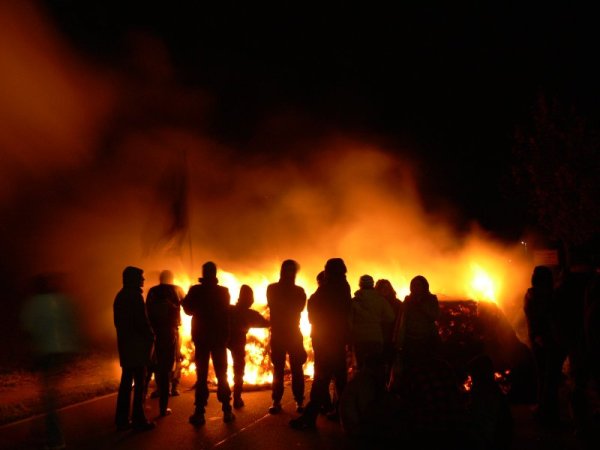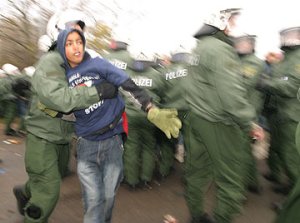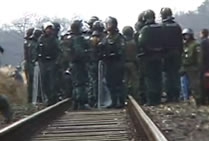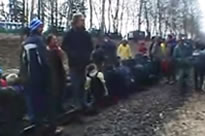Nuclear Waste Transport In Germany
18.11.2005 18:27 | Ecology | World
Since November 19, yet another transport with twelve containers of radioactive waste (called 'Castor') from the plutonium plant La Hague (France) is on its way to the so called interim storage in Gorleben in the Wendland region, an area ( Map ) well known for 20 years of resistance to nuclear power. The transport is scheduled to arrive in Gorleben monday evening. The police announced that they will send at least 11,000 local and federal cops into the region.
After the death of the French activist Sébastien Briat during the protests in 2004, both police and activists expect a more heated atmosphere for this transport.
Update Tuesday November 22, 06.30: Between 4:00 and 5:00 in the morning, thousands of police have finally managed to clear a small corridor for the transport ("north route"). At 6:00 the transport reaches the interim storage at Gorleben, moving not faster than 15km/h on the last 20km. See the timeline for updated infos and pictures of the protest.
Monday November 21: at 8.15am the transport reaches Lüneburg while thousands of protestors in the area are on the roads to welcome it on the last 70km. All over the day, blockades and other actions prevented the transport from reaching its destination. See the timeline for details.
Sunday November 20: Hundreds of people spread into the woods along the railway tracks, setting up barricades [pictures 1 | 2] on roads to sabotage police logistics for tonight when the transport is expected in the region. Tractors are being used to block the special police forces. Farmers blocked the tranport route close to Gorleben with 120 tractors ( picture ), later in the night they were cleared by police forces. On its way through Southern Germany, the train was stopped several times by blockades. An unknown number of people are arrested.
Saturday, November 19: 4000 people demonstrate in Hitzacker, where the transport will pass on Monday. [Pictures 1 | 2 ] Meanwhile, at 17.30, the transport has left the plutonium plant in France. [video] In the evening, 350 people blockaded the main road from Lüneburg to Dannenberg at the village Metzingen, setting barricades on fire [ pictures].
Friday November 18: 600 pupils demonstrated (en) in Lüchow throwing a "rain of eggs" at the police. Police forces tried to clear the demonstration later and injured several pupils.
Indymedia (en): one | two | three | Videos at KanalB | French News Ticker | Chronology of the Resistance(en)1977-1999 | Village of Resistance Metzingen (de)

Burning barricades at Metzingen, Germany
As in previous years, direct actions have already taken place weeks before the expected transport. In October more then 100 containers - the accommodation of police troops were burnt down causing a damage of more than 3 million euros while nobody was hurt. It was the most militant act against the transports since activists burned down a whole railway bridge on the way to Gorleben in autumn 2001. This week, anti-atom activists also used anchors to destroy the contact wire of the railways in northern Germany. Police say on 17 November, that they prevented an attempt to hollow out a road with water.
The containers are transported by train to Lüneburg, where they have to go another 50km by train on a single-track railway, heavily secured by police forces against sabotage and blockades. After that the containers have to be moved on trucks for another 20km by road to Gorleben.
The biggest clash of police and activists took place in Wendland in March 2001, when about 10,000 activists met almost 30,000 police, making the tranport stop for almost one day and about 1,000 people arrested in 48 hours.
Interestingly, the weekly transportation of spent fuel-rods the length and breadth of the UK, from nuclear power plants to Sellafield in Cumbria, has aroused no significant protest in the last decade, with the exception of the Mark Thomas Comedy Product report | pictures
Although police try to divide locals and protestors from all over Germany and France by 'tolerating' some local protest and marking 'foreigners' as 'anarchist rioters', connections are in some parts stronger then ever, most of the protest camps organized by both locals and people coming to the area for protest. In Metzingen, a small village halfway up the railway track to Dannenberg, local people offer accommodation in their houses to hundreds of protestors - calling the town a "place of resistance", supplying foot and transport logistics for people who want to stay during the days of protest.

Pupils demonstrating in Lüchow while cops try to clear the demonstration.
Additions
Additional informations
19.11.2005 02:10
 http://castor.de/english/wendish.html (english language)
http://castor.de/english/wendish.html (english language) For minute-to-minute reports from the transport and resistance along the way from france to germany, click here:
 http://castor.de/english/2005/day_x_live.htm (english language..the newsticker in german will be most likely faster)
http://castor.de/english/2005/day_x_live.htm (english language..the newsticker in german will be most likely faster) And for other reports, images, videos ect. check out de.indymedia.org (mnostly german language)
skep
Video from 2001
19.11.2005 13:29
It's a realy good video-document to get a feeling about what is happening there every year. Some parts are in german (ppl speak to the camera), but most parts are just pure videoimpressions.
Videostream:
 http://www.interpool.tv/video/ausnahmezustand_64.ram (low quality version)
http://www.interpool.tv/video/ausnahmezustand_64.ram (low quality version)  http://www.interpool.tv/video/ausnahmezustand_512.ram (high quality verson)
http://www.interpool.tv/video/ausnahmezustand_512.ram (high quality verson)
skep


Comments
Display the following 4 comments